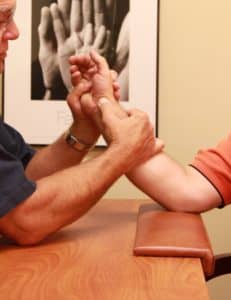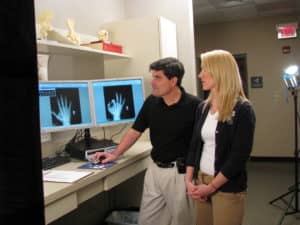Thumb Basilar Joint Arthritis
What is Basilar joint arthritis of the thumb?

Basilar joint arthritis of the thumb, also known as CMC (Carpal-MetaCarpal) joint arthritis, is a very common but treatable condition. The CMC joint of the thumb is where the metacarpal bone of the thumb attaches to the trapezium bone of the wrist, and it allows for thumb flexion and extension as well as rotational movement. This complex joint is anchored by the volar oblique ligament. Frequently, as we age, the volar oblique ligament will weaken or rupture. This causes the CMC joint to dislocate. The loss of congruency of the metacarpal bone to the trapezium bone causes a progressive loss of cartilage. With the thinning of the cartilage and the creation of bone-on-bone contact in the thumb, osteophyte formation occurs, bony projections that form along joint margins. The patient will experience pain as well as deformity to the thumb with the thumb in a typical flexed posture with fullness at the base of the hand. Patients will notice pain with any pinch and grasp activity, and a common symptom is pain experienced when twisting the lid of a jar.
Diagnosis

In general, a diagnosis is made during a physical examination, as the patient will have the typical physical indicator, fullness in the base of the thumb. The patient will experience pain, as the bones rub against each other. Other symptoms include hypermobility and crepitation, or crackling, in the CMC joint when the bone rubs upon the bone. X-rays will confirm the evidence of the loss of joint congruency, the narrowing of the cartilage and the initiation of the osteophyte formation.
Treatment
Initial treatment options are conservative and include braces to the area of the thumb base (a hard Orthoplast or soft Neoprene) combined with taking anti-inflammatory medications. Although these improve the symptoms, they do somewhat limit the patient’s ability to perform activities. It is very common that the patient’s symptoms progress while splinting and taking anti-inflammatory medication. If this occurs, the patient can receive a steroid injection. A steroid injection directly in the area of the CMC joint frequently provides very effective relief for a period of three to six months. Unfortunately, the symptoms will reoccur as the steroid’s effectiveness dissipates. After several injections or if the symptoms have not improved by bracing, anti-inflammatory medication and injections, the patient will be offered the option of surgery.
The surgical procedure is a joint replacement-type surgery. In the surgery, the trapezium or teacup bone that supports the thumb metacarpal is removed. The joint is reconstructed by using a tendon transfer to recreate the volar oblique ligament and provide a spacer. In some cases, a fiber wire button is used to stabilize the base of the thumb in place of a tendon transfer. The fiber wire may be particularly useful in patients who are young and who require power grip function of the hand. Typically, this is an outpatient procedure, meaning the patient goes home the same day of the operation. After surgery, a patient will undergo a physical therapy program with bracing, range-of-motion exercises and strengthening over the next four to eight weeks. However, even after physical therapy, patients generally continue to improve significantly for a period of three to six months. The operation is a very satisfying procedure because it can recreate the patient’s utilization of the thumb without pain, although sometimes residual soft tissue bracing may be necessary during certain activities.

Dr. Sharkey is Board Certified in General Surgery as well as Plastic and Reconstructive Surgery with additional qualifications in Hand Surgery. Dr. Sharkey attended medical school at the University of Illinois, where he also completed his residency in General Surgery. He completed his residency in Plastic Surgery at St. Louis University, followed by fellowship training in Hand Surgery at Christine M. Kleinert Institute for Hand and Microsurgery in Louisville, KY. Dr. Sharkey is an active member of the American Society for Plastic and Reconstructive Surgery.

